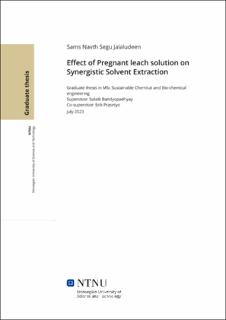| dc.description.abstract | Battery recycling is gaining increased traction in today’s world for myriad reasons, with the chief
ones being the dwindling availability of raw materials and heightened ecological consciousness.
While there exist certain established methods for recycling batteries at their end-of-life, the efficacy
of these methods remains uncertain and they do not recover all battery components evenly. Modern
batteries predominantly consist of lithium, nickel, manganese, and cobalt. Interestingly, while over
half of the NMC material is recuperated at a global level, the recovery rate for lithium is a meagre
1%. This can primarily be attributed to the lack of commercially viable techniques for extracting
lithium from battery black mass. Consequently, bridging this disparity by augmenting lithium
recovery from spent batteries is of critical importance. A method that has often proven to be
the most economically viable for extraction is solvent extraction. This method, referred to as
synergistic solvent extraction (SSX), boosts extraction efficacy by simultaneously utilizing two or
three extractants. Thus, in the present master’s thesis, SSX will be deployed to selectively extract
lithium from the leach solution of spent battery waste, employing a combination of the cationic
extractant HTTA (2-thenoyl trifluoro acetone) and neutral extractant TOPO (trioctylyphosphine
oxide), with kerosene serving as the diluent.
The PLS used in this study was obtained as a result of another researcher’s work which needed
to separate lithium from it. The study focused on lithium extraction from a synthetic Pregnant
Leach Solution (PLS) by manipulating pH, Aqueous to Organic ratios (A/O ratios), sulfuric acid
concentration, and the ratio between the lithium-loaded organic phase and stripping liquor (O/A
ratio). It was found that an increase in pH led to a decrease in lithium concentration due to higher
ammonium levels, whereas a pH of 9.5 resulted in a significant improvement in lithium extraction,
achieving about 83% efficiency. The addition of toluene helped in improving phase separation while
TBP did the opposite. Increasing sulfuric acid concentration up to 0.5M improved the stripping
efficiency, but anything beyond led to an efficiency drop due to higher ammonium co-stripping.
Increasing the O/A ratio resulted in a more concentrated lithium strip liquor and maintained
high stripping efficiency, reaching a lithium concentration of around 22 g/l with less than 2 g/l
of co-stripped ammonium. However, the presence of ammonium in higher concentrations led to
more co-stripping, indicating a need to strike a balance between the ammonium concentration
and lithium extraction efficiency. Despite certain anomalies, the final strip solution contained
approximately 22 g/l of lithium and only 0.5 g/l of ammonium, which is promising. | |
